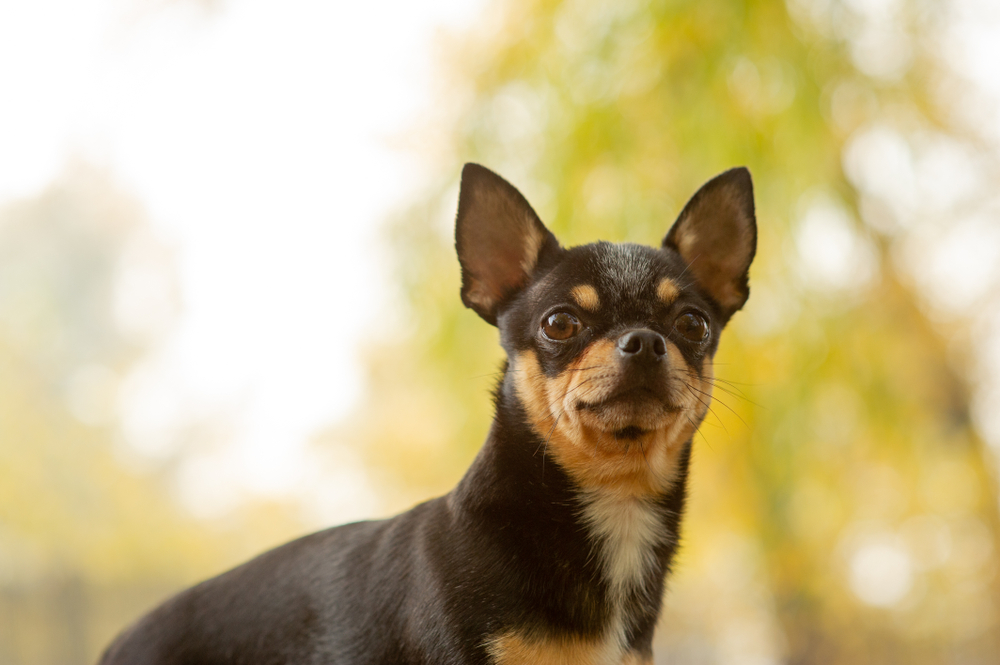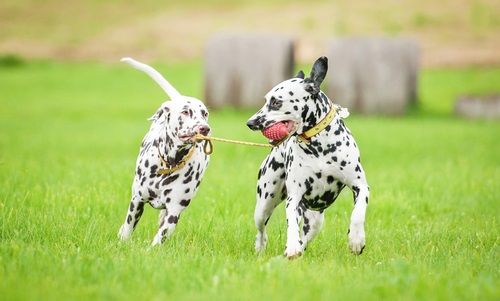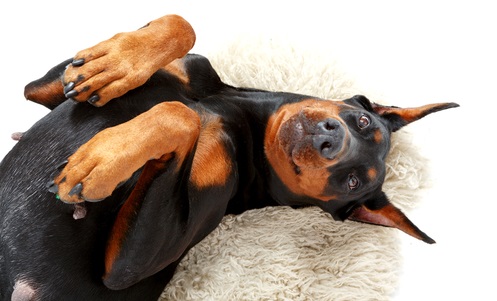Like human personalities, dog personalities vary greatly. Whereas some dogs rarely bark, others frequently snarl and show their teeth, turning a nice afternoon in the park into an embarrassing or even damaging outing.
Before you adopt a puppy or full-grown dog, it’s helpful to know which breeds tend to be more aggressive than others. This way, you can choose the best dog for you and your family. Want a big softie? Know which breeds to avoid. Conversely, if you’re on the lookout for good guard dogs and opt for a more aggressive breed, you can be prepared with strategies for helping your pooch calm down. In the same breath, it is also important to know at what age dogs are fully grown in order to prepare properly for getting guard dogs.
There’s a lot of misinformation out there regarding the most aggressive dog breeds. In this blog post, we’ll cover everything you need to know about aggression in dogs—from the five most “aggressive” breeds to the true root causes of aggression and the best ways to address them.
The Five Most Aggressive Dog Breeds
Any list of most aggressive dog breeds is bound to call out the same breeds. For instance, Rottweilers and German shepherds will almost always appear.
But when it comes to which dog breeds are most aggressive, it’s important to remember that you shouldn’t blame the whole breed for the actions of one dog.
That said, here are the five breeds with the greatest tendency to exhibit aggression (in no particular order):1
Breed #1: Chihuahua
Although considered the smallest breed in the world, chihuahuas are frequently cited as one of the most aggressive. They are known to be extremely loyal but can be very jealous and possessive when strangers approach their owners.
What does that mean?
- Chihuahuas are known for their yappy bark, and while it may seem cute at first, it’s actually a sign of pint-sized aggression.
- Some chihuahuas dislike children, perhaps because young humans don’t have the best etiquette around dogs.
- Temperamental chihuahuas may bite children they don’t know.
Of course, as with all dog breeds, the key is training and socializing your chihuahua.
Breed #2: Doberman Pinscher
Originating in Germany and bred for protection, Doberman pinschers are highly intelligent and loyal.
However, like chihuahuas, they have very protective instincts when it comes to their owners and will lash out at strangers.
This can be an asset when training a Dobermen pinscher, and they are often used as police dogs and for guard duties.
But if they’re not well-trained, Doberman pinschers may be extremely possessive of their people as well as their own possessions (i.e., toys and food bowls). Without proper training, this can cause issues at the dog park and in other social situations.
Breed #3: Rottweiler
Like the Doberman pinscher, the rottweiler was originally bred in Germany, acquiring its name from the town of Rottweil. Loyal and protective, they were once used for bear hunting and cattle herding before taking on their modern roles as army and police dogs.
If you need a dog to defend your home, the rottweiler is for you. However, due to their size and possessiveness, they’re not always the best dogs for families with toddlers or young children.
Breed #4: Chow Chow
Another small dog with a big attitude, chow chows are not recommended for first-time dog owners. The problem is their assertiveness.
- They will occasionally show dominance when around other dogs or strangers.
- Due to a lack of peripheral vision, they tend to be easily startled.
This means that chow chow’s don’t always place nice with other pups. If you’re looking for a second dog or you plan to frequent highly-trafficked trails and parks, make sure you’re prepared to adequately train and socialize your chow chow.
Breed #5: Dalmatian
Rising to fame thanks to Disney, dalmatians are playful, inquisitive dogs that need to be socialized at an early age.
If not properly socialized, dalmatians are known to develop behavioral issues—especially around strangers. However, if properly socialized, they’re great to have around children.
What Makes Dogs Aggressive?
If you’re a dog lover, you’ve probably already met a dog who defied the above rules, whether it was an ultra-chill chihuahua or a rottweiler with a heart of gold.
At its core, aggression is another way dogs “communicate.” For instance, a dog may demonstrate aggressive behavior when it’s annoyed or terrified of another human, dog, or situation.
This is not to say that certain breeds aren’t more genetically predisposed towards aggressive behavior, as some dogs were bred for hunting and protection. But it is to say that aggression is a form of communication we should listen to if we want to lessen these uncomfortable situations.
To that end, let’s look at the most common causes of aggression in dogs2.
Fear-Based Aggression
Although some dogs display their fear by cowering or hiding, others lash out. Dogs that show fear-based aggression are often dogs who’ve felt “trapped” in the past or who’ve been subjected to harsh punishments.
If your dog has had previous owners, you may find yourself wishing you knew what he’d been through. While this is often impossible, there are plenty of ways to offer support.
When dogs display this type of aggression, the best thing to do is give the dog space. Other ways to lessen this type of aggression include:
- Turning off distractions and stimuli to calm the dog down
- Identifying which stimuli made the dog afraid
- Taking steps to desensitize the dog to fear-inducing stimuli
If your dog continually shows signs of situational anxiety, you might want to consider supplementing your dog’s diet with CBD and hemp-based products. CBD can be effective in helping calm dogs who become stressed in certain situations. Check out Canna-Pet CBD treats for an organic way to help calm your nervous dog.
Pain-Based Aggression
Dogs who are in pain generally don’t want to be touched. And unwanted touching, even to soothe the pain, causes some dogs to turn aggressive. This is especially true with older dogs who may growl at children after experiencing “rough play.”
The best thing to do to help a dog displaying pain-based aggression is to take the dog to the vet as soon as possible. You may also want to separate the dog from children by using baby gates or crates.
Play-Based Aggression
It’s no surprise that some of the most aggressive dogs are often the most playful. This is because there’s sometimes a very fine line between fighting and play. Play-based aggression often stems from one dog being overly “playful” with another. This causes the annoyed dog to lash out at its playmate.
To mitigate this type of aggression, make sure all dogs in a playgroup are compatible with each other and monitor their play.
Possession-Based Aggression
This type of aggression is more common in dogs bred for guard duties, as these breeds are trained to protect their resources. This type of aggression most often arises when a human (or another dog) takes away the dog’s objects—their toys, food bowl, etc.
Lessen this aggression by showing your dog that even though you’re around their food bowl or other possession, you pose no threat.
Social-Based Aggression
Also known as “dominance aggression,” social-based aggression occurs when a conflict exists between a dog’s wishes and his owner’s. For instance, a dog that doesn’t want to be put in a crate or moved off the couch may violently snap at its owner if the owner uses physical force.
A good way to lessen this type of aggression is to use “treat-oriented approaches” as opposed to using force. For instance, instead of pushing your dog off the couch, throw a treat on the floor so that they are motivated to get down.
Whichever type of aggression your dog displays, remember that aggression is an act of communication.
How To Calm Aggressive Dogs
Just because a dog exhibits aggressive behavior doesn’t mean its nature is inherently aggressive. In fact, there are many things you can do to calm aggressive dogs. Whether you have a feisty chihuahua or rambunctious rottweiler, do the following to calm your aggressive dog:3
- Identify stimuli that trigger aggression: Dogs may be triggered by many stimuli—from sirens to other dogs. Do your best to identify these stimuli and work to desensitize your dog to them over time.
- Keep your emotions in check: It’s easy to become frustrated with an aggressive dog. However, because dogs mimic our emotions, showing your frustration and annoyance will cause your dog to reflect these same attitudes. Do your best to keep a calm demeanor when dealing with an aggressive dog.
- Exercise your dog daily: Dogs that feel trapped or unstimulated may revert to aggressive behaviors. Ensure your dog is both physically and mentally stimulated by exercising together daily.
- Avoid harsh punishments: It’s ok to occasionally crate your dog as punishment, but avoid overly aggressive displays of punishment such as yelling and physical force.
- Consider supplementing your dog’s diet with CBD and hemp nutrition: Like humans, dogs’ brains have cannabinoid receptors, making them receptive to CBD and hemp-based products. If you’re thinking about giving your dog CBD, it’s important to remember that CBD doesn’t contain the same psychoactive properties as THC. Rather, CBD helps to relax your dog, easing worried thoughts that may lead to aggression.
Calming Your Dog with Canna-Pet
Although some breeds are more likely than others to display aggressive behavior, it’s important to remember that with the right training and socialization, all breeds can make happy, playful pets.
Aggression in dogs stems from several causes. But the good news is that in most cases, aggressive behavior can be greatly lessened. By exercising your dog daily, showing love and support, and supplementing your dog’s diet with our CBD and hemp-based products from Canna-Pet, you can keep your dog frolicking—not showing his fangs.
Sources:
- Pet Helpful. 10 Most Aggressive Dog Breeds: Temperament Ratings and Information. https://pethelpful.com/dogs/10-Most-Aggressive-Dog-Breeds-Temperament-Ratings-and-Information
- Whole Dog Journal. What Causes Aggressive Dog Behavior? https://www.whole-dog-journal.com/behavior/what-causes-aggressive-dog-behavior/
- BarxBuddy. How to Calm an Aggressive Dog. https://www.barxbuddy.com/blog/calming-an-aggressive-dog/







